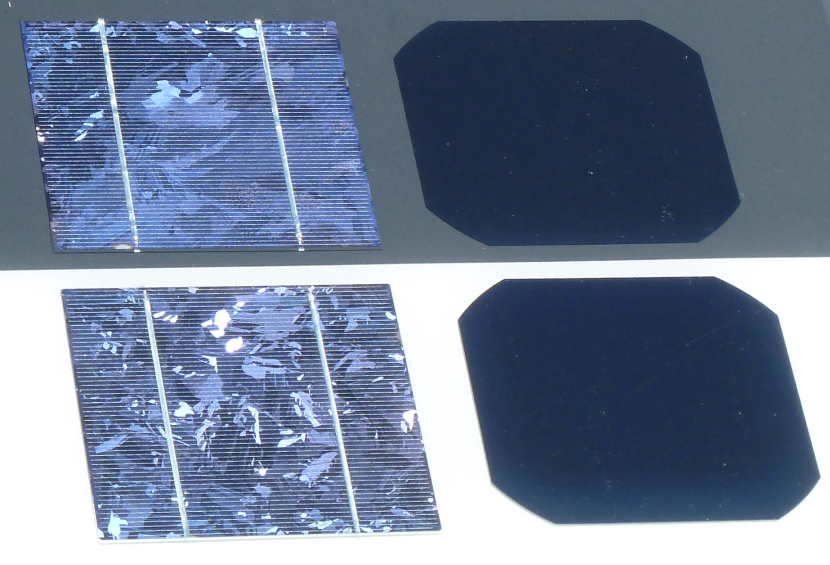Monocrystalline solar panel vs. polycrystalline
The first set of terms describes how solar cells are made from raw materials. Solar cells are traditionally made from silicon, which is a conductor. Natural silicon wafers are formed into uniformly sized silicon cells by the manufacturer. There are two types of solar cells: Monocrystalline (made from a single silicon source) and polycrystalline (made from multiple silicon sources). Below we explain the differences between them.
- Monocrystalline solar cells have a better efficiency rate since they are made from a single type of silicon.
- Polycrystalline solar cells are made from multiple silicon sources and have lower efficiency.
- Compared to mono and poly panels, thin-film technology is less expensive and less efficient. These panels are typically used for large commercial projects.
- An N-type cell resists light-induced degradation better than a P-type cell.
- PERC cells have a reflective surface that gives them a second opportunity to absorb light.
- Solar cells with half-cut ribbons are more efficient because a smaller ribbon transports electrical current, which reduces resistance in the circuit.
- Bifacial solar panels absorb light on both sides of the meeting.
- As a result, solar manufacturing has branched into a wide range of cell technologies. It can be unclear to figure out why you should pick one option over the other.
- Ever wondered about the difference between monocrystalline vs. polycrystalline solar panels? Or N-type vs. P-type cells? You’re in the right place. This article will give a high-level overview of the powerful solar cell technologies in play and explain the pros and cons of each.
What are monocrystalline solar panels?
Solar panels with monocrystalline cells are made up of silicon ingots cut from a single crystalline crystal. Because each cell is made from a single piece of silicon, the composition of these cells is purer. Thus mono panels have a slightly higher efficiency than poly ones. Furthermore, they perform better in high heat and low light environments, producing close to their rated output even under less than ideal conditions.
Nevertheless, they are more expensive to produce, and their higher price is passed on to the buyer. Compared to poly panels of the same wattage, mono panels are more expensive. Their production process also produces more waste than poly panels. The mono panels are made from square silicon wafers with their corners shaved off, creating the unique shapes shown in the picture below. Due to their single piece of silicon construction. However, that is only a matter of personal taste. I prefer the look of these to poly panels.
What are polycrystalline solar panels?
Polycrystalline solar cells are made up of multiple silicon pieces combined. Solar cells are made from smaller pieces of silicon that are molded and treated. Since very little raw material is wasted during manufacturing, this process is less wasteful. Poly panels have a distinctive blue color due to the combination of cells. If you look at them up close, you’ll see the texture and color are uneven due to how the cells are made.
Solar panels made of polycrystalline silicon are slightly less efficient than monocrystalline silicon due to imperfections in their surface. Since they are cheaper to manufacture, they are more affordable for the end-user.
Thin Film Solar Panels
Monocrystalline and polycrystalline solar cells make up the majority of solar panels deployed today. Thin-film solar panels, usually installed in large-scale projects and some specialty applications, are the third type of solar technology. The thin-film panels are produced by depositing a thin conductive material layer onto a glass or plastic backing plate.
Most thin-film panels are not used in residential installations since they are less efficient than mono or poly panels. Residential customers have limited roof space, so they opt for more traditional crystalline silicon panels for maximum production. On the other hand, Thin film technology is less expensive to manufacture and becomes more cost-effective on a larger scale. Thin film technology’s lower efficiency does not matter in commercial and industrial projects with no restrictions on space. Thin-film panels are usually the most cost-effective option when these situations arise.
Additionally, thin-film technology allows solar panels to be flexible, such as those found on RVs and boats. The thin films can be deposited onto the plastic to create flexible solar panels because they are (as the name implies) much more delicate than traditional silicon wafers. RVs and mobile homes are excellent places to use these panels since they may not have a flat surface to mount them on.
Solar Cells: N-Type vs. P-Type
The previous section described the process of forming raw material into silicon wafers. In this section, you will learn about the process of making a functioning solar cell from wafers that can generate an electric current.
P-Type Solar Cells
P-type cells are usually constructed from silicon wafers doped with boron. A positively charged cell is formed when boron has one less electron than silicon. Cells of the P-type suffer from light-induced degradation, resulting in an initial reduction in output. Light treatment has historically been the most popular treatment method.
N-type solar cells
Unlike silicon cells, N-type cells are negatively charged because they are doped with phosphorus, which has one extra electron over silicon. Consequently, N-type cells are not affected by the light-induced degradation caused by boron-oxygen defects. Because they degrade less over the panel’s lifetime, these are positioned as a premium option.
Cells in most of the panels we sell are P-type, which degrade slower but still perform well for over 30 years. With P-type cells being less expensive, it typically makes sense to opt for a cheaper module that spoils slightly more than a considerably more costly panel with slightly less degradation. However, as N-type technology advances and costs decrease, that assessment may change.
Read More: A Complete Guide About What Is Sump Pump Basement? Its Types, Working And Installation
PERC Cells
Passivated Emitter and Rear Cell technology are called PERC. The passivation layer on the backside of the solar panel distinguishes PERC cells from other solar panels. Consider it to be a reflective layer. Solar cells can absorb a second chance of light that the committee has reflected. Solar radiation is absorbed by the cells more efficiently, so panels are more efficient.
The PERC cell technology is gaining traction because the passivation layer does not add a significant manufacturing delay or cost. The efficiency boost more than compensates for the extra manufacturing step. Also Solar has a good article that details PERC technology’s history and technical information.




